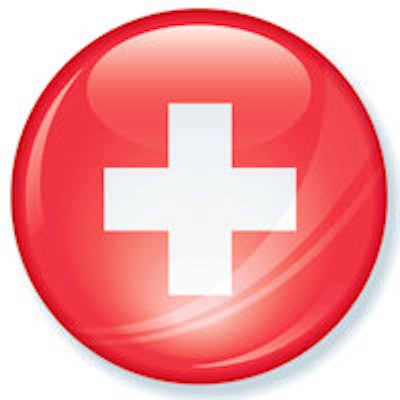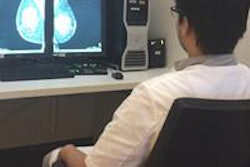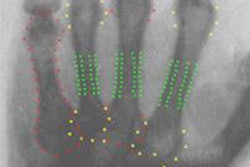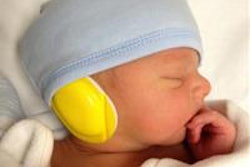
Swiss, Dutch, French, and German speakers who present at ECR have the highest conversion rate into publications, while the profiles of researchers from Japan, Korea, China, and India are rising fast, according to a new study.
The success of presenters from these four European nations most likely is due to the promotion of academic radiology, noted Dr. Will Loughborough, registrar in clinical radiology at Southmead Hospital, North Bristol National Health Service (NHS) Trust, U.K., and his colleagues. Interestingly, Switzerland, the Netherlands, France, and Germany do not have the most dense radiologist populations in Europe, and the latter three countries are not among the top five countries by MRI or CT scanner per capita, they stated.
"The four Asian nations of Japan, South Korea, China, and India have progressed over a period of significant economic change. Our data infers that these nations have established themselves as major contributors to global radiological research," Loughborough et al pointed out.
The authors evaluated all oral publications from ECR 2010 for journal publication between 2010 and 2013, using the Medline database. They excluded published manuscripts in journals not indexed by journal citation reports (n = 28), as well as abstracts from countries with less than 10 oral abstracts (n = 36). Cox regression was used to estimate a publication rate over time, and hazard ratios for each nation, relative to the host country of Austria.
The team calculated publication rates per physician per 1,000 population for the submitting country using World Bank population data, and then they ranked countries by publication rate and compared ECR 2010 data with analogous data from ECR 2000.
| Publication percentages at ECR 2010 by country of origin | |||||
| Country | No. of abstracts | No. of articles | Publication % | % articles in top quartile | Publications/physician/1,000 |
| Austria | 36 | 12 | 33 | n/a | 2.5 |
| Switzerland | 39 | 24 | 62 | 33 | 5.8 |
| France | 38 | 23 | 61 | 39 | 6.8 |
| The Netherlands | 46 | 27 | 59 | 52 | 9.3 |
| Japan | 21 | 11 | 52 | 18 | 4.8 |
| Korea | 33 | 17 | 52 | 18 | n/a |
| Germany | 222 | 101 | 46 | 24 | 27.3 |
| U.K. | 37 | 17 | 46 | 24 | 6.3 |
| Greece | 16 | 7 | 44 | 29 | 1.1 |
| Italy | 138 | 50 | 36 | 12 | 13.5 |
| U.S. | 35 | 13 | 37 | 38 | 5.4 |
| China | 52 | 18 | 35 | 11 | 12 |
| Spain | 15 | 3 | 20 | n/a | 0.75 |
| India | 11 | 1 | 9 | n/a | 1.7 |
The overall proportion of presentations published in 2010 (360/840 = 43%) was higher than 2000 (403/1,020 = 39%). Switzerland had the highest publication percentage (62%) and publication rate (19/year) in 2010, which was more than 2.5 times higher than the host nation (p = 0.01). Germany had the highest number of publications per physician per 1,000 of the population in 2010 (27.3) and 2000 (49). The Netherlands had the highest percentage of journals in the top quartile of impact factors in both 2010 (52%) and 2000 (54%).
Meanwhile, Japan, Korea, China, and India had increased publication rates and improved rankings over the 10-year period.
"The conversion rate of abstracts presented at meetings into original manuscripts in the peer-reviewed literature is a gauge of scientific quality of the meeting and its participants," Loughborough and colleagues wrote. "There is a paucity of such data examining radiology-specific conferences."
Subspecialty focus
The group also assessed the impact factors of publishing journals and publication rates of oral abstracts, according to subspecialty, modality, and study design.
From 840 orally presented abstracts, 360 (43%) were subsequently published. From 16 represented radiology subspecialties, pediatrics had the highest publication rate of 63% (17/27). Gastrointestinal studies had the highest overall number of abstracts presented and published (137 and 52). Non "pure radiology" subspecialty categories (physics, quality improvement, and computer studies) had the lowest conversion into published manuscripts. Safety issues had the highest percentage of articles in the top quartile of impact factor journals (83%) and highest mean impact factor (4.6) of all subspecialty categories.
PET/CT, MRI, and CT were the top modalities in terms of conversion rate into published manuscripts (49%, 47%, and 43% respectively), explained the authors. MRI had the most abstracts and publications (157/334). Fluoroscopy, radiography, mammography, and nuclear medicine (non-PET) converted less than a third of presented abstracts into published articles. In terms of study design, prospective studies had a marginally higher publication rate of 49% (142/289), versus 48% (57/117) of retrospective studies. However, prospective studies had a higher percentage of abstracts in top quartile impact factor journals (29% versus 19%).
"Our study shows that modality and subspecialty type influence conversion of oral abstracts at ECR into full publication. Pediatrics and gastrointestinal are particularly successful specialties in publishing orally presented studies," they stated.
Their data suggest PET/CT, MRI, and CT are leading modalities in terms of published research. High impact factor journals seem to consider prospectively acquired data more favorably than retrospective, but both study designs had similar rates of publication.
Furthermore, the group found the addition of authors and increased collaboration between institutions was significantly associated with high impact factor journal publication.
"Increasing authorship can potentially broaden the academic capacity of a paper through increased access to resources and expertise for analysis," they wrote. "However, another consideration is that publication potential is arguably increased by collaborating with authors affiliated to specific journals." they wrote.
Increasing patient number was not associated with higher impact factor journals, they continued. This is perhaps because the abstracts presented at ECR already had high numbers of study numbers (mean of 205) and therefore adding patient numbers did not significantly increase the power of studies.
Loughborough and his co-authors have written up the study as a manuscript and submitted it to the European Radiology journal, and it is currently under review.
"We are in the process of writing up a second manuscript, with a focus on the subspecialty data. Additionally, we collected data on how oral abstracts were adapted prior to publication, and which adaptations were associated with high impact factor journal publication, which we may submit as a further manuscript," they told AuntMinnieEurope.com.



















